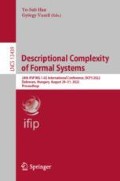Abstract
Several canonical forms of finite automata have been introduced over the decades. In particular, if one considers the minimal deterministic finite automaton (DFA), the canonical residual finite state automaton (RFSA), and the átomaton of a language, then the átomaton can be seen as the dual automaton of the minimal DFA, but no such dual has been presented for the canonical RFSA so far. We fill this gap by introducing a new canonical automaton that we call the maximized prime átomaton, and study its properties. We also describe how these four automata can be extracted from suitable observation tables used in the automata learning context.
This work was supported by the Estonian Research Council grant PRG1210. H. Maarand was also supported by the ERDF funded Estonian CoE project EXCITE (project 2014-2020.4.01.15-0018).
Access this chapter
Tax calculation will be finalised at checkout
Purchases are for personal use only
References
Angluin, D.: Learning regular sets from queries and counterexamples. Inf. Comput. 75(2), 87–106 (1987). https://doi.org/10.1016/0890-5401(87)90052-6
Birget, J.: Intersection and union of regular languages and state complexity. Inf. Process. Lett. 43(4), 185–190 (1992). https://doi.org/10.1016/0020-0190(92)90198-5
Bollig, B., Habermehl, P., Kern, C., Leucker, M.: Angluin-style learning of NFA. In: Boutilier, C. (ed.) IJCAI 2009, Proceedings of the 21st International Joint Conference on Artificial Intelligence, Pasadena, California, USA, 11–17 July 2009, pp. 1004–1009 (2009). http://ijcai.org/Proceedings/09/Papers/170.pdf
Brzozowski, J.A.: Canonical regular expressions and minimal state graphs for definite events. In: Proceedings of Symposium on Mathematical Theory of Automata. MRI Symposia Series, vol. 12, pp. 529–561. Polytechnic Press, Polytechnic Institute of Brooklyn, N.Y. (1963)
Brzozowski, J.A., Tamm, H.: Theory of átomata. Theor. Comput. Sci. 539, 13–27 (2014)
Denis, F., Lemay, A., Terlutte, A.: Residual finite state automata. Fund. Inform. 51, 339–368 (2002)
Iván, S.: Complexity of atoms, combinatorially. Inf. Process. Lett. 116(5), 356–360 (2016)
Kameda, T., Weiner, P.: On the state minimization of nondeterministic finite automata. IEEE Trans. Comput. 19(7), 617–627 (1970)
Lombardy, S., Sakarovitch, J.: The universal automaton. In: Flum, J., Grädel, E., Wilke, T. (eds.) Logic and Automata: History and Perspectives [in Honor of Wolfgang Thomas]. Texts in Logic and Games, vol. 2, pp. 457–504. Amsterdam University Press (2008)
Myers, R.S.R., Adámek, J., Milius, S., Urbat, H.: Coalgebraic constructions of canonical nondeterministic automata. Theor. Comput. Sci. 604, 81–101 (2015)
Nerode, A.: Linear automaton transformations. Proc. Amer. Math. Soc. 9, 541–544 (1958)
Tamm, H.: Generalization of the double-reversal method of finding a canonical residual finite state automaton. In: Shallit, J., Okhotin, A. (eds.) DCFS 2015. LNCS, vol. 9118, pp. 268–279. Springer, Cham (2015). https://doi.org/10.1007/978-3-319-19225-3_23
Tamm, H.: New interpretation and generalization of the Kameda-Weiner method. In: 43rd International Colloquium on Automata, Languages, and Programming (ICALP 2016). Leibniz International Proceedings in Informatics (LIPIcs), vol. 55, pp. 116:1–116:12. Schloss Dagstuhl-Leibniz-Zentrum für Informatik, Dagstuhl (2016)
Tamm, H., van der Merwe, B.: Lower bound methods for the size of nondeterministic finite automata revisited. In: Drewes, F., Martín-Vide, C., Truthe, B. (eds.) LATA 2017. LNCS, vol. 10168, pp. 261–272. Springer, Cham (2017). https://doi.org/10.1007/978-3-319-53733-7_19
Author information
Authors and Affiliations
Corresponding author
Editor information
Editors and Affiliations
Rights and permissions
Copyright information
© 2022 IFIP International Federation for Information Processing
About this paper
Cite this paper
Maarand, H., Tamm, H. (2022). Yet Another Canonical Nondeterministic Automaton. In: Han, YS., Vaszil, G. (eds) Descriptional Complexity of Formal Systems. DCFS 2022. Lecture Notes in Computer Science, vol 13439. Springer, Cham. https://doi.org/10.1007/978-3-031-13257-5_14
Download citation
DOI: https://doi.org/10.1007/978-3-031-13257-5_14
Published:
Publisher Name: Springer, Cham
Print ISBN: 978-3-031-13256-8
Online ISBN: 978-3-031-13257-5
eBook Packages: Computer ScienceComputer Science (R0)


